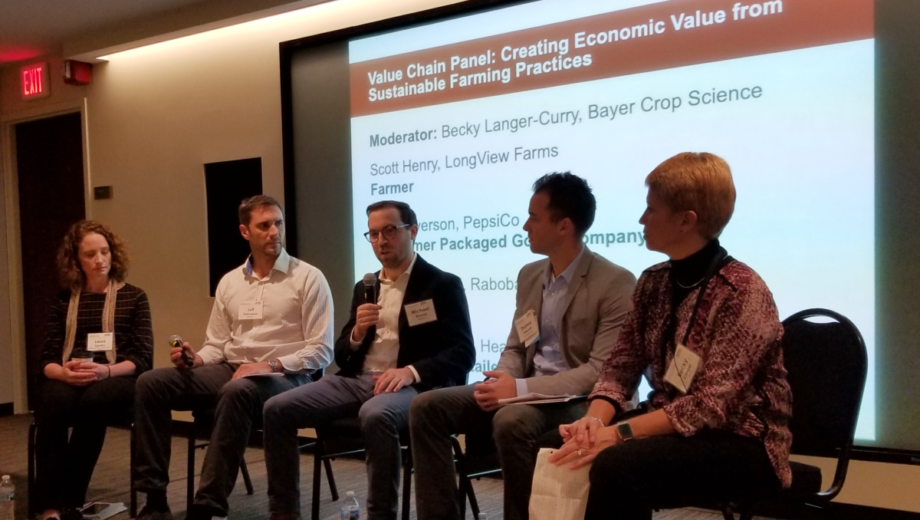
Midwest Row Crop Collaborative pushes for action on conservation finance in agriculture
Members of the Midwest Row Crop Collaborative are working on using conservation finance as a key pathway for achieving their vision of a US agricultural system with healthy soils, that protects water, addresses the factors contributing to climate change, and supports farm families
Hosted at Bayer’s campus in St. Louis late last month, the Forum on Conservation Finance in Agriculture brought together a group of leading organizations and key stakeholders in the agriculture system— including lenders, agricultural retailers, farmers, companies, and nonprofits—to explore how the economic benefits of sustainable farming can be captured at different parts of the value chain through the mechanism of conservation finance. The event marked an important step forward in advancing the role of finance in supporting adoption of conservation and good farming practices in the US agricultural system.
 Conservation finance includes a range of strategies that monetize environmental goods or services in some form, whether by cost-savings, generating cash flows, or the appreciation of land and resource values overall. These strategies can be used to help drive adoption of good farming practices. But questions remain about the whether the adoption of these practices make financial sense in the long run.
Conservation finance includes a range of strategies that monetize environmental goods or services in some form, whether by cost-savings, generating cash flows, or the appreciation of land and resource values overall. These strategies can be used to help drive adoption of good farming practices. But questions remain about the whether the adoption of these practices make financial sense in the long run.
Research from Environmental Defense Fund has found that:
- Conservation practices can pay, most often through cost savings and longer-term yield benefits. Practices have integrative effects and can vary by farm.
- Getting it right takes time and effort and depends on good farm and records management.
- Conservation benefits are often unrecognized and unrewarded by farmers’ financial partners.
The day was designed to identify and create new opportunities for conservation finance leaders to take action. Group exercises revealed barriers to adoption that include lack of data and understanding of value versus risk, difficulty in coordinating across complex supply chains, a lack of incentives, and a disproportionate amount of risk falling on the farmer.
Looking beyond the barriers, participants developed a vision for the adoption of good farming practices through conservation finance where data about value and risk is robust and informs coordinated pilot projects designed to scale, engaging farmers, lenders, companies, public sector, and consumers. Within five years, participants could see a world where conservation is valued by the agricultural value chain, including consumers, and risk is shared to incentivize practice adoption.
To drive the day towards identifying action steps, the participants broke into groups to explore a set of potential financial models introduced by experts in the field—including lending products, outcomes-based financing, leveraging offtake relationships, and ecosystems markets. Some fruitful conversation led to a set of exciting potential actions, such as supply chain companies exploring opportunities to provide loan support for sustainable practice adoption.
One of the strongest themes to emerge from the day is the need for more and better data to prove the value of applying conservation finance and good farming practices. Multiple speakers encouraged the group to start testing conservation finance products and approaches to build the evidence base.

Ultimately, farmers are the foundation of the entire value chain—a fact well recognized by the participants. For conservation finance to have an impact, farmers need to experience the benefits of how adopting these practices can help them to be successful. There are positive stories emerging about how good farming practices provide real financial benefits, but we need more to form a sound, data-driven case for much broader adoption.
The Collaborative sincerely appreciated the enthusiasm for generating new possibilities to utilize conservation finance as a lever for a more sustainable agricultural system. We were glad to hear that participants valued the forum, made new connections, and formed some concrete next steps. As a Collaborative, we’re looking forward to future opportunities to bring leaders together to push the conversation forward and find opportunities to catalyze action for a more sustainable agricultural system.